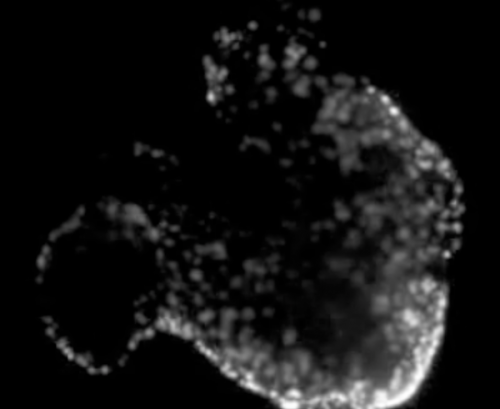Researchers uncover optimal framework for heartbeats

(Medical Xpress)—The heart maintains a careful balancing act; too soft and it won't pump blood, but too hard and it will overtax itself and stop entirely. There is an optimal amount of strain that a beating heart can generate and still beat at its usual rate, once per second.
In a study published in the journal Current Biology, researchers at the University of Pennsylvania have shown that this "sweet spot" depends on the stiffness of the collagen framework that the heart's cells live within. They also have shown that the other biophysical factors that contribute to the strength of the heartbeat adjust alongside the natural stiffening of collagen during embryonic development, keeping the growing heart in this optimal zone.
Taking into account the role that this collagen matrix plays in the optimal heartbeat could help cardiologists repair tissue after a heart attack, where scarring stiffens the heart's collagen.
"If we can understand more clearly the effects on cells of normal and damaged collagen frameworks, then we can develop better treatments for the frameworks as well as the cells within," said Dennis Discher, professor in the Department of Chemical and Biomolecular Engineering in the School of Engineering and Applied Science.
Discher and lead author Stephanie Majkut, a member of his lab and a doctoral candidate in the Department of Physics and Astronomy in Penn's School of Arts and Sciences, conducted the study along with other members of Discher's lab, Joe Swift and Christine Krieger. They collaborated with physics professor Andrea Liu and Timon Idema, a member of her lab.
The study's experiments were conducted on embryonic chick hearts, which are anatomically similar to human hearts during early development. The researchers chemically treated the beating hearts to either stiffen or soften the collagen matrix surrounding the cells. The treatment made it either harder or easier for the cell's molecular motors, proteins known as myosins, to contract the heart muscle.
After testing that their treated hearts were sufficiently softened or stiffened, they fluorescently labeled a small percentage of cells in the heart so they could quantify how hard the hearts were beating while looking at them under a microscope.
"When we treat the hearts with a chemical that breaks down the collagen," Majkut said, "we can directly see that the hearts aren't contracting as much because the labeled cells aren't getting as close to each other as they did before."
"The same effect was also seen when we treated the hearts with a chemical that helps the collagen crosslink and stiffen itself. Eventually, those hearts simply stop beating all together," she said.
The researchers saw that the further along the embryos were in maturation, the stiffer the "sweet spot" for their optimal beating was. As the collagen matrix of the heart stiffened, the concentration of the myosin motor proteins that contract the muscle increased along with it to keep pace.
"We also showed this dynamic on the level of the individual cell with heart cells and stem cell derived heart cells," Discher said. "We put isolated cells on gels that have the stiffness of the native heart, or else we make the gel softer or stiffer, and we see the same optimum. Surprisingly, the cells working together in heart tissue are even more sensitive to the stiffness of their environment."
Cardiologists might one day use such stiffness-optimized gels for growing heart tissue from stem cells to replace just the scarred and damaged parts of a patient's heart. A better fundamental understanding of the role collagen stiffness plays in the heartbeat could underpin other treatments as well.
"There were hints of this stiffness effect with adult hearts before, but this study made it very clear that the heart muscle cells are optimized from 'day one' to do work against the native stiffness they see in collagen, and that all of the factors that determine this relationship change in a coordinated way as the heart develops so it can stay in that sweet spot," Discher said.

















